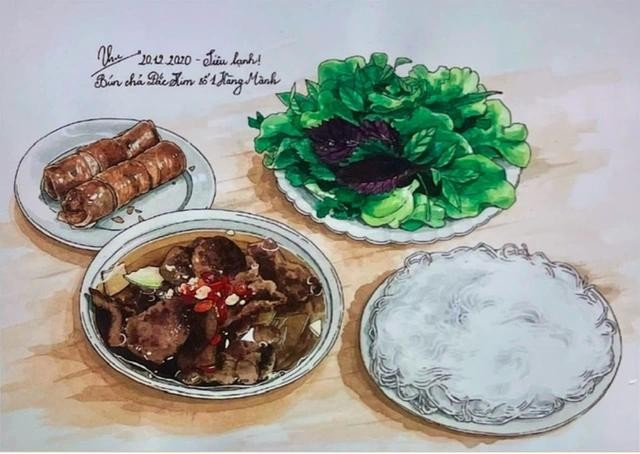A notable trend is that most Michelin-recognised street eateries are clustered in the Old Quarter in Hoàn Kiếm ward and adjacent areas.

A painting by Thu Hằng in the sketchbook project “Flavours of the Hà Nội”.
HÀ NỘI — Several Hà Nội street-side eateries have earned recognition from Michelin, but the question remains: is this enough to elevate the city's vibrant street food scene?
Hoàn Kiếm bún chả, phở take the spotlight
From its very first year in Việt Nam, the Michelin Guide was quick to take note of bún chả (rice vermicelli with grilled pork and fresh herbs), a humble yet iconic dish from Hanoi. In 2023, two bún chả spots made it into Michelin’s recommended list: Bún chả Đắc Kim on Hàng Mành street and bún chả Hương Liên on Lê Văn Hưu street.
That same year, other sidewalk eateries such as Bà Xuân Steamed Rolled Pancakes on Hoè Nhai street, Châm Chicken phở (rice noodle) on Quán Thánh Street, and Tiến phở on Nguyễn Trường Tộ street were also spotlighted.
These dishes, particularly bún chả and phở, were further recognised in the “good food at reasonable prices” category.
In subsequent years, the list has grown to include phở Khôi Hói and Phở Lâm, Châm Chicken Phở on Yên Ninh Street, and Chinh Thắng Phở Cuốn. Other humble dishes such as the eel vermicelli from Đông Thịnh and Chân Cầm eateries, or the nostalgic countryside-style perch soup from Hiệu Lực on Hai Bà Trưng street, have also made their way into the guide.
A notable trend is that most Michelin-recognised street eateries are clustered in the Old Quarter in Hoàn Kiếm ward and adjacent areas. Yet despite global acclaim, no bánh mì (Vietnamese baguette) vendor has been featured, an absence that food experts find surprising given its international reputation and even inclusion in the Oxford Dictionary as a Vietnamese-style sandwich. In 2024, bánh mì was listed among the world’s best sandwiches, yet it remains absent from Michelin’s radar.
A foundation for growth, but more is needed
There are currently no official statistics on whether Michelin recognition has caused a significant surge in patronage at these eateries. However, from a culinary tourism standpoint, this attention presents an opportunity, especially if supported by a strategic plan. For instance, multiple bún chả restaurants gaining recognition could create a ripple effect, boosting the visibility of other outstanding bún chả establishments across the capital.
One approach is to develop cultural projects that spotlight Hà Nội's culinary richness. The recently launched sketchbook project Flavours of the Old Quarter highlights many highly rated bún chả spots, such as those tucked away in Hàng Quạt, Bát Sứ, Cửa Đông, and Gia Ngư streets. Author Phạm Tiến Long notes that seasoned locals still frequent hidden gems in
Đồng Xuân market or on Lương Ngọc Quyến and Nguyễn Du streets, where traditional bún chả que tre, grilled pork skewers on bamboo sticks, is served.
Long also pointed to a small but thoughtful gesture at Michelin-recommended Đắc Kim: “Western visitors often recommend the spot to friends because it’s frequently mentioned in Hà Nội travel and food guides. The restaurant is considerate enough to keep forks in the chopstick holders, anticipating guests who may not be used to chopsticks.”
This detail highlights an important point: if bún chả alone can spark Michelin interest, other Hà Nội street foods also deserve curated recognition. At the same time, upgrading services, like offering utensils for international guests, goes a long way in enhancing the overall experience.
According to Dr. Nguyễn Thu Thủy from the Vietnam National University, to elevate Hà Nội's street food, vendors must first ensure their offerings are distinctive, something that builds a unique brand identity. Food safety, friendly and enthusiastic service, and active digital communication are also essential. Engaging customers on social platforms can help turn them into ambassadors for the business.
She added that street vendors should aim to serve both dine-in and takeaway customers. Embracing technology, such as food delivery apps, not only reduces staffing needs but also helps manage operations efficiently, offering visuals, prices, and ordering options to customers.
Thủy noted that food tech service providers are now readily available, and integrating these solutions could significantly improve service quality. — VNA/VNS